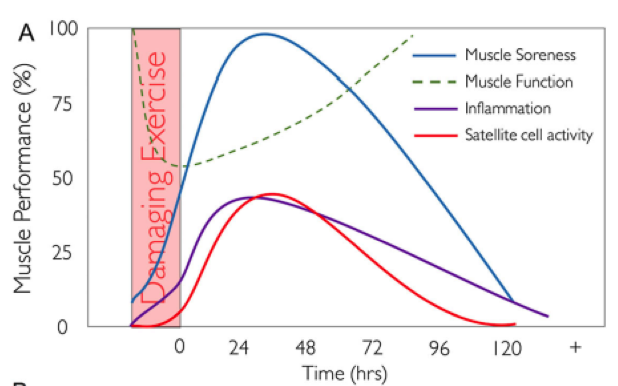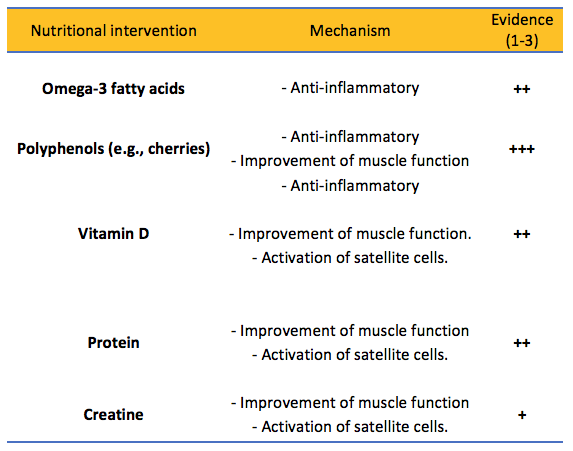Exercise-induced muscle damage and the consequent muscle pain, commonly known as ‘stiffness’, conditions our performance. In the last decades, there has been a great controversy around the origin of stiffness, from the traditional thought that it occurs due to the crystallisation of lactic acid to the current evidence that shows that it’s a consequence of the mechanical damage produced to the muscle fibres (which mainly occurs with high eccentric exercises, such as damping jumps or during a race, especially if it is downhill).
In particular, stiffness seems to be caused by damage in the contractile and skeletal structures of the muscle fibre, given that when the membranes of the muscle fibre break (including internal ones such as that of the sarcoplasmic reticulum), they cause an accumulation of intracellular calcium, the activation of calcium-dependent proteolytic pathways, and the increase in inflammatory processes that cause pain and a decrease in performance.1 As shown in Figure 1, after an exercise that causes muscle damage, there is an immediate drop in performance followed by a progressive increase in inflammation and muscle pain, peaking 24-48 hours after the exercise. Concomitantly, satellite cells will be activated, which are undifferentiated cells capable of adapting and turning into muscle cells to help recover the damaged tissue.

What Can We Do from a Nutrition Standpoint?
Considering how muscle damage and pain affect our athletic performance, athletes often look for strategies to avoid them or, at least, reduce its intensity. As summarised by Owens et al. in a recent review published in the European Journal of Sport Science,2 from a nutritional point of view, there are various strategies that can help us (Table 1).

As muscle damage involves the disruption of fibrous membranes, the intake of protein (for example, through the consumption of milk or whey protein) after exercise will help us to increase protein synthesis and, thereby, favour the regeneration of muscle tissue. In fact, when muscle damage occurs, a large part of the available protein will regenerate damaged tissue, so protein consumption must be increased – especially if our goal is muscle hypertrophy.3
Also, an increase in oxidative stress and pro-inflammatory processes is produced after mechanical damage, the intake of anti-oxidant or anti-inflammatory food (such as those containing polyphenols like cherries or pomegranate) could help reduce these processes. Similarly, other anti-inflammatory food, such as those rich in Omega 3 polyunsaturated fatty acids (like salmon or tuna) and vitamin D, could also be beneficial in alleviating the inflammatory response to muscle damage. Ultimately, some studies suggest that creatine could stimulate the growth and activation of satellite cells, thus contributing to the regeneration of muscle fibres after muscle damage.4 Consequently, creatine supplementation after muscle damage could be potentially beneficial, although more studies are needed to confirm this hypothesis.
Nevertheless, it is important to mention as we have expressed in previous articles for other strategies such as cold, blocking oxidative stress or inflammation that takes place with muscle damage. It can attenuate the adaptations produced by exercise, as these play a key role in anabolic processes and muscle regeneration to occur. For this reason, these strategies may be convenient if you want to avoid a decrease in performance for subsequent sessions (e.g. the need to be at peak performance in a match). On the other hand, excessive blocking of inflammatory responses may not be recommended if you are looking to maximise adaptations produced by training sessions (e.g. during the preseason).
Conclusion
When we perform an exercise which we are not used to, especially if it has a high eccentric component, muscle damage can occur with the consequent stiffness, which will limit our performance for the next sessions. This is why the first strategy to avoid the incidence of stiffness will be optimal planning of training sessions so as not to excessively increase the training load. Nevertheless, there are some nutritional strategies that can help reduce stiffness once it occurs, which include from the intake of proteins to promote muscle regeneration, to the consumption of foods with anti-inflammatory properties.
Pedro Valenzuela
References
- McKune A, Semple S, Peters-Futre E. Acute Exercise-Induced Muscle Injury. Biol Sport [Internet]. 2012 Jan;29(1):3–10. Available from: http://biolsport.com/abstracted.php?level=5&ICID=978976
- Owens DJ, Twist C, Cobley JN, Howatson G, Close GL. Exercise-induced muscle damage: What is it, what causes it and what are the nutritional solutions? Eur J Sport Sci [Internet]. 2019;19(1):71–85. Available from: https://doi.org/10.1080/17461391.2018.1505957
- Damas F, Libardi CA, Ugrinowitsch C. The development of skeletal muscle hypertrophy through resistance training: the role of muscle damage and muscle protein synthesis. Eur J Appl Physiol [Internet]. 2018;118(3):485–500. Available from: http://dx.doi.org/10.1007/s00421-017-3792-9
- Olsen S, Aagaard P, Kadi F, Tufekovic G, Verney J, Olesen JL, et al. Creatine supplementation augments the increase in satellite cell and myonuclei number in human skeletal muscle induced by strength training. J Physiol. 2006;573(2):525–34.
KNOW MORE
CATEGORY: MARKETING, COMMUNICATION AND MANAGEMENT
This model looks to the future with the requirements and demands of a new era of stadiums, directed toward improving and fulfilling the experiences of fans and spectators, remembering “feeling” and “passion” when designing their business model.
CATEGORY: FOOTBALL SPORTS PERFORMANCE
Through the use of computer vision we can identify some shortcomings in the body orientation of players in different game situations.
CATEGORY: MEDICINE HEALTH AND WELLNESS
A health check must detect situations which, despite not showing obvious symptoms, may endanger athletes subject to the highest demands.
CATEGORY: FOOTBALL TEAM SPORTS
In the words of Johan Cruyff, “Players, in reality, have the ball for 3 minutes, on average. So, the most important thing is: what do you do during those 87 minutes when you do not have the ball? That is what determines whether you’re a good player or not.”
CATEGORY: MEDICINE HEALTH AND WELLNESS SPORTS PERFORMANCE
Muscle injuries account for more than 30% of all injuries in sports like soccer. Their significance is therefore enormous in terms of training sessions and lost game time.
DO YOU WANT TO KNOW MORE?
- SUBSCRIBE
- CONTACT
- APPLY
KEEP UP TO DATE WITH OUR NEWS
Do you have any questions about Barça Universitas?
- Startup
- Research Center
- Corporate